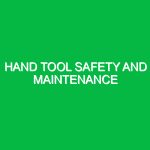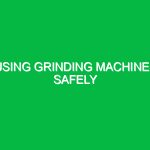Compressed air tools have revolutionized various industries, from construction to automotive repair. They offer efficiency and power that surpasses manual tools. However, the dangers of compressed air tools cannot be overlooked. Understanding these risks is crucial for ensuring health, safety, and environmental (HSE) compliance. This article delves into the potential hazards associated with compressed air tools, emphasizing the importance of safety precautions and regulatory adherence.
Understanding the Risks: What Are the Dangers of Compressed Air Tools?
Compressed air tools operate by using compressed air to accomplish tasks. While they provide significant advantages, they also pose several dangers that can lead to serious injuries or even fatalities. Here are some of the primary risks associated with these tools:
1. High-Pressure Injuries
One of the most immediate dangers of compressed air tools is the risk of high-pressure injuries. Compressed air can easily penetrate the skin, leading to air embolisms, tissue damage, or even death. In a real-life incident, a maintenance worker was using a compressed air nozzle to clean machinery. A sudden release of air struck him in the abdomen, resulting in severe internal injuries. This incident underscores how even routine tasks can lead to catastrophic outcomes.
2. Hearing Damage
The noise generated by compressed air tools can be deafening. Prolonged exposure to high-decibel levels can result in permanent hearing loss. The Occupational Safety and Health Administration (OSHA) states that noise levels above 85 decibels can be hazardous. Workers using pneumatic tools without hearing protection risk developing noise-induced hearing loss. In the automotive industry, for example, it’s common to hear air impact wrenches generating noise levels upwards of 100 decibels. This emphasizes the need for ear protection in such environments.
3. Eye Injuries
Another significant hazard is the risk of eye injuries. Compressed air can propel debris at high speeds, potentially causing severe injuries to the eyes. According to the American Academy of Ophthalmology, an estimated 30,000 eye injuries occur each year due to workplace accidents involving tools and machinery. A vivid example can be found in manufacturing environments where metal shavings or dust can be forcibly ejected by compressed air, leading to serious ocular trauma if proper eye protection is not utilized.
4. Respiratory Issues
Using compressed air for cleaning can inadvertently aerosolize harmful substances, leading to respiratory problems. Dust, mold, or chemicals can be disturbed, creating airborne particles that workers could inhale. In one case study, workers in a woodworking shop reported respiratory issues after using compressed air to clean sawdust. The airborne particles exacerbated pre-existing conditions like asthma, highlighting the potential health risks associated with incorrect use of compressed air tools.
5. Slips, Trips, and Falls
Compressed air tools can also contribute to slips, trips, and falls. Hoses can create tripping hazards on the shop floor, and compressed air can blow debris onto walking paths. In a construction site scenario, a worker tripped over an air hose while carrying heavy equipment, resulting in a serious fall and injury. Such incidents emphasize the importance of maintaining a clear workspace and securing hoses to prevent accidents.
Best Practices and Safety Precautions
Understanding the dangers of compressed air tools is only the first step. Implementing safety precautions and best practices is essential to mitigate these risks. Here are some actionable recommendations:
1. Proper Training
Before using compressed air tools, workers should receive comprehensive training. This should cover the correct operation of tools, hazard recognition, and emergency procedures. Organizations can hold workshops or safety meetings to ensure all workers are informed and capable of recognizing potential dangers. For instance, a manufacturing company might conduct monthly safety drills that include proper techniques for using compressed air safely.
2. Use Personal Protective Equipment (PPE)
Employing appropriate PPE is crucial. Workers should wear safety goggles to protect against flying debris, ear protection to guard against noise, and respiratory masks if necessary. In one scenario, a technician experienced an eye injury while using a compressed air tool without proper eye protection. This incident could have been avoided had the technician adhered to PPE guidelines.
3. Regular Equipment Maintenance
Ensuring that tools and equipment are regularly maintained can prevent accidents. Air hoses should be inspected for leaks, and tools should be checked for damage before use. A case in point is a construction company that implemented a weekly inspection schedule for all pneumatic tools, significantly reducing incidents related to equipment failure.
4. Establish Clear Work Procedures
Creating and adhering to clear work procedures can help minimize risks. This includes designating specific areas for using compressed air tools and establishing protocols for cleaning tasks. Workers should be encouraged to report any unsafe conditions or practices immediately. For example, a clear guideline might include always using compressed air for its intended purpose, such as cleaning or operating machinery, rather than for tasks like blowing off clothing or personal items.
5. Proper Hose Management
Managing air hoses effectively can reduce tripping hazards. Using hose reels or securing hoses with cable ties can keep workspaces tidy. Additionally, workers should be trained to avoid dragging hoses across walkways or high-traffic areas.
Regulations and Standards Governing Compressed Air Tools
Compliance with regulations and standards is a critical aspect of managing the dangers of compressed air tools. Various organizations provide guidelines to ensure worker safety:
1. OSHA Regulations
The Occupational Safety and Health Administration (OSHA) has established regulations regarding the safe use of compressed air. For example, OSHA mandates that workers using compressed air for cleaning must not use air pressure exceeding 30 psi unless the nozzle is equipped with a safety device. Understanding these regulations helps organizations maintain compliance and ensure worker safety.
2. ANSI Standards
The American National Standards Institute (ANSI) provides additional guidelines related to pneumatic tools. ANSI/ISA-12.13.01 specifies safety requirements for using pneumatic tools, including design, maintenance, and operational procedures. Familiarity with ANSI standards can enhance safety measures and reduce risk.
3. Industry-Specific Guidelines
Different industries may have specific guidelines tailored to their unique risks. For instance, the American Industrial Hygiene Association (AIHA) offers resources for managing respiratory hazards in industries where compressed air is prevalent. Organizations should consult these resources to ensure comprehensive safety practices.
Conclusion: The Importance of Awareness and Safety in Using Compressed Air Tools
The dangers of compressed air tools are significant and multifaceted. From high-pressure injuries to respiratory issues, the risks are real and can have severe consequences. However, by implementing proper safety precautions, adhering to regulations, and fostering a culture of safety, organizations can significantly reduce these risks. Awareness and training are key components that empower workers to understand and mitigate the dangers associated with compressed air tools. Safety is not just a practice; it’s a commitment to protecting every individual in the workplace. By prioritizing health, safety, and environmental considerations, we can ensure that the use of compressed air tools remains beneficial, efficient, and above all, safe.


